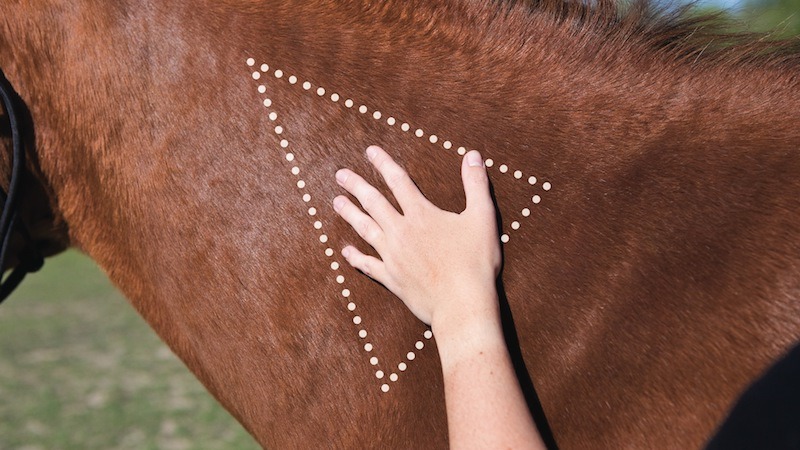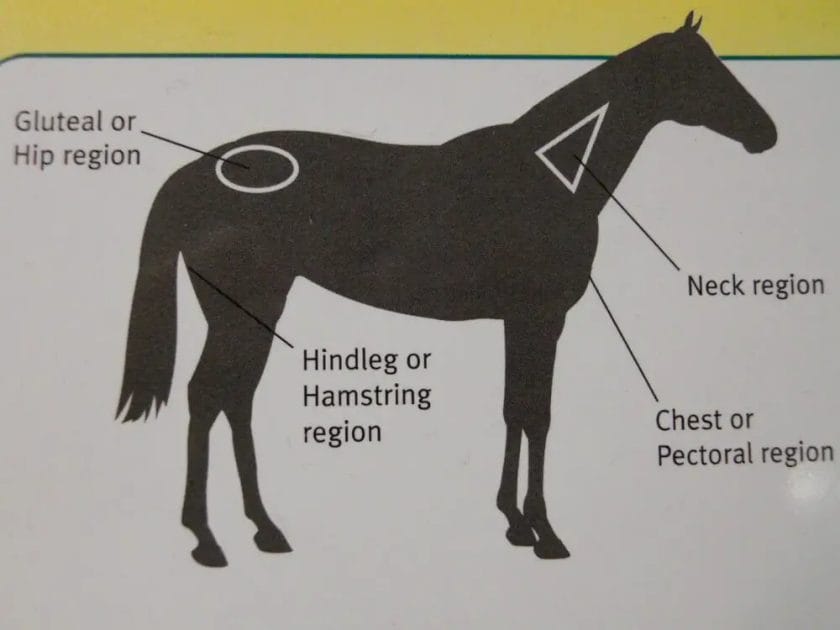Administering a shot to a horse’s neck is a crucial skill for horse owners and veterinarians alike. It is essential to know the correct technique to ensure the comfort and safety of the horse during the process. By following proper guidelines and handling the horse with care, you can effectively give a horse a shot in the neck without causing any harm or discomfort.
Before administering a shot, it is important to consult with a veterinarian to ensure you have the appropriate medication and dosage. The veterinarian can also guide you on the proper injection technique and any specific precautions to take.
To begin, you should prepare the medication and syringe as instructed by your veterinarian. Make sure to sanitize the injection site and your hands to minimize the risk of infection. When handling the horse, it is crucial to approach it calmly and assertively to establish trust and prevent unnecessary stress.
The next step is to locate the appropriate injection site on the horse’s neck. The most common location is the neck muscle, halfway between the poll and withers. Gently part the hair in this area to expose the skin to make the injection process easier.
Once you have accessed the injection site, slowly insert the needle at a 90-degree angle to the horse’s skin. Take care to avoid any blood vessels or bones in the neck. Administer the medication slowly and steadily as per the veterinarian’s instructions.
After injecting the medication, remove the

Step-by-Step Guide to Giving a Horse a Shot in the Neck
Giving a horse a shot in the neck may seem like a daunting task, but with proper preparation and technique, it can be done safely and effectively. This step-by-step guide will walk you through the process of administering a shot to a horse in the neck.
Step 1: Gather the necessary supplies
Before you begin, make sure you have all the necessary supplies on hand. This includes the medication or vaccine you will be administering, a clean syringe and needle, alcohol wipes or disinfectant solution, cotton balls, and a sharps container for proper disposal of used needles.
Step 2: Prepare the horse
Ensure that the horse is securely tied or held by a handler who can safely control and calm the horse during the procedure. Choose a quiet and well-lit area to work in.
Step 3: Cleanse the injection site
Using an alcohol wipe or disinfectant solution, thoroughly clean the injection site on the horse’s neck. This helps prevent any potential infection.
Step 4: Assemble the syringe and needle
Attach the needle to the syringe, making sure it is securely in place. Draw the appropriate amount of medication into the syringe, following the instructions provided with the medication or vaccine.
Step 5: Administer the shot
Approach the horse’s neck from the side and locate the injection site. Using your non-dominant hand, gently hold the horse’s neck to stabilize it. With your dominant hand, insert the needle into the injection site at a 45-degree angle.
Slowly depress the plunger to administer the medication. Make sure to do this steadily to avoid any discomfort to the horse. Once the medication is fully administered, withdraw the needle from the horse’s neck.
Step 6: Dispose of the needle properly
Immediately after administering the shot, place the used needle in a designated sharps container for proper disposal. Do not attempt to recap the needle or dispose of it in regular trash, as this can pose a risk of injury.
Step 7: Observe the horse
After giving the shot, observe the horse for any adverse reactions or signs of discomfort. If necessary, consult a veterinarian for further guidance.
Step 8: Document the administration
Keep a record of the date, medication administered, dosage, and any other relevant information in your horse’s medical records. This helps ensure accurate tracking of vaccinations or treatments.
In summary, administering a shot to a horse in the neck requires careful preparation, proper technique, and consideration for the horse’s well-being. By following this step-by-step guide, you can safely and effectively give a horse a shot in the neck.

Ensuring a Painless and Stress-free Injection Process for Your Horse
Administering injections to your horse is a necessary part of their healthcare routine. Whether it’s for vaccinations, medication, or routine treatments, it’s important to ensure that the injection process is as painless and stress-free as possible for your equine companion. By following a few simple steps and understanding the needs of your horse, you can make the injection process a calm and comfortable experience.
1. Preparation is Key
Before giving your horse an injection, it’s crucial to prepare everything you need in advance. This includes the medication or vaccine, a clean and sterile syringe, alcohol wipes for disinfecting the injection site, and any other necessary supplies. Organize your materials in a clean and well-lit area, ensuring that everything is within reach.
2. Proper Restraint and Handling
Proper restraint and handling of your horse is essential to prevent accidents and keep both you and your horse safe during the injection process. If your horse is not accustomed to injections, it’s advisable to have an experienced handler or veterinarian assist you.
Ensure that your horse is securely tied or held in a safe enclosed area. If necessary, use a head collar or halter to have better control over their head. Communicate with your horse using a calm and reassuring voice, providing gentle strokes to help them relax.
3. Identify the Injection Site
It’s important to correctly identify the injection site before proceeding. Consult the medication or vaccine instructions or speak with your veterinarian to determine the appropriate location for the injection. Common sites for injections include the neck muscle or the base of the tail.
Thoroughly clean the injection site using an alcohol wipe or another suitable disinfectant. This helps prevent infection and ensures that the injection is as sterile as possible.
4. The Needle and Injection Technique
When using a syringe, it’s essential to choose the appropriate needle gauge and length for the specific injection. A longer needle may be necessary for deeper muscle injections, while a shorter needle can be used for subcutaneous injections.
Hold the syringe firmly and remove any air bubbles by gently tapping the syringe and pushing the plunger until a small amount of the medication or vaccine is expelled.
Insert the needle into the injection site at the correct angle and slowly administer the medication or vaccine. Take your time to ensure a smooth and controlled injection, avoiding any sudden movements or jerking motions. If necessary, gently massage the injection site afterward to help disperse the medication.
5. Post-Injection Care
After administering the injection, provide your horse with a calming and reassuring environment. Monitor them closely for any signs of adverse reactions or discomfort. If required, consult with your veterinarian for post-injection care and any further instructions.
Dispose of the used needle and syringe properly, following local regulations and guidelines for biohazardous waste disposal.
6. Building Trust and Positive Associations
The more your horse associates the injection process with positive experiences, the easier it will become over time. Reward your horse with praise, treats, or a favorite activity after the injection to create positive associations.
Regular handling and desensitization exercises can also help your horse become more comfortable with injections. Gradually introduce the sensation of having a needle near their body, rewarding them for calm behavior.
In Summary
Administering injections to your horse doesn’t have to be a stressful experience. By properly preparing, handling your horse with care, and following correct injection techniques, you can ensure a painless and stress-free process. Remember to consult your veterinarian for specific advice and guidance tailored to your horse’s individual needs. Building trust and positive associations will also contribute to a smoother injection experience in the long run.

Safety Precautions for Administering Injections in a Horse’s Neck
Administering injections is a common veterinary procedure, and it is essential to follow proper safety precautions to ensure the well-being of both the horse and the person administering the injection. When it comes to injecting medications into a horse’s neck, it is crucial to take extra precautions due to the sensitivity and delicacy of the area. In this section, we will discuss some important safety measures to consider while administering injections in a horse’s neck.
1. Proper Restraint and Handling
Before administering an injection, it is important to ensure that the horse is properly restrained and comfortable. Use appropriate equipment, such as a halter and lead rope, to safely control the horse’s movements. Make sure the horse is calm and relaxed before proceeding with the injection.
2. Cleanliness and Sterility
Prior to administering an injection, it is crucial to maintain a clean and sterile environment. Wash your hands thoroughly and use sterile gloves to prevent the introduction of bacteria into the injection site. Clean the injection site with an antiseptic solution to minimize the risk of infection.
3. Proper Needle Size
Choosing the right needle size is important to ensure safe and effective administration of the medication. Using a needle that is too large can cause unnecessary pain and tissue damage. Conversely, a needle that is too small may not deliver the medication properly. Consult with a veterinarian to determine the appropriate needle size for the specific medication and horse.
4. Correct Injection Technique
Proper injection technique is crucial to minimize discomfort and potential complications. Insert the needle at a 90-degree angle into the horse’s neck, avoiding any major blood vessels or nerves. Aspirate the syringe to check for blood before injecting the medication to ensure that the needle is not in a blood vessel. Administer the medication slowly and steadily to prevent discomfort and swelling.
5. Disposal of Sharps
After administering the injection, it is essential to dispose of the used needle and syringe properly. Never recap the needle, as this can lead to accidental needle sticks. Place the used sharps in a puncture-resistant container designated for sharps disposal. Follow local regulations and guidelines for the safe disposal of medical waste.
6. Monitoring the Horse
Once the injection is administered, closely monitor the horse for any adverse reactions or complications. Keep an eye on the injection site for signs of infection, such as redness, swelling, or discharge. If any concerns arise, consult with a veterinarian immediately.
7. Documentation
It is important to maintain accurate and detailed records of all injections administered to a horse. Include information such as the date, medication administered, dosage, location of the injection, and any observed reactions. This documentation is valuable for future reference and helps ensure proper care and treatment.
In summary, administering injections in a horse’s neck requires strict adherence to safety precautions. Proper restraint, cleanliness, correct needle size, and injection technique are essential to minimize discomfort and potential complications. Additionally, proper disposal of sharps and close monitoring of the horse are crucial. By following these safety measures, we can ensure the well-being of the horse and those involved in the administration of injections.
Mastering the Art of Giving Injections to Horses: Neck Administration
Giving injections to horses is an essential skill for horse owners and caretakers. It allows for the administration of medications, vaccines, and other treatments that are vital for the horse’s health and well-being. One of the most common sites for administering injections in horses is the neck. In this section, we will explore the proper technique and considerations for giving injections in the neck area.
Choosing the Injection Site
When it comes to giving injections in horses, the neck is a popular choice due to its accessibility and relatively large muscle mass. However, it is crucial to select the correct injection site to ensure the safety and effectiveness of the procedure.
The ideal location for neck injections is the area halfway down the neck, between the poll and the withers. This region provides a sufficient muscle mass for injection without posing a risk to vital structures such as the spinal cord or major blood vessels.
Preparing for the Injection
Before administering any injection, it is essential to prepare the horse and gather all the necessary supplies. Here are the steps to follow:
- Ensure that you have the correct medication or vaccine prescribed by a veterinarian.
- Gather the necessary equipment, such as a sterile syringe, needle, and alcohol swab.
- Prepare the injection site by cleaning it thoroughly with an alcohol swab.
The Injection Technique
Once the horse and supplies are ready, it’s time to administer the injection. Follow these steps to ensure a successful and safe procedure:
- Hold the syringe with the needle facing upward and remove any air bubbles by gently tapping the syringe and expelling the excess solution.
- Approach the horse calmly and gain its trust. Speak softly and maintain a gentle demeanor throughout the process.
- Locate the selected injection site on the neck and identify the appropriate injection angle. The angle should be approximately 45 degrees to the horse’s skin.
- Using your non-dominant hand, stabilize the horse’s neck by placing it just above the intended injection site.
- With your dominant hand, insert the needle swiftly and smoothly into the muscle at the predetermined angle. Be confident and avoid hesitation to minimize discomfort for the horse.
- Once the needle is properly inserted, use your thumb or finger to depress the plunger and administer the medication or vaccine.
- Remove the needle gently and apply firm pressure to the injection site using a clean cotton ball or gauze pad to prevent any bleeding.
Aftercare and Best Practices
After giving the injection, it is crucial to provide proper aftercare for the horse. Here are some essential guidelines:
- Dispose of used needles and syringes in designated sharps containers to ensure safety.
- Observe the injection site for any signs of inflammation, swelling, or infection. Contact a veterinarian if any abnormalities occur.
- Keep a record of the injection, including the date, medication or vaccine administered, dosage, and any observed reactions or side effects.
- Follow the recommended injection schedule and consult with a veterinarian for guidance on specific medications and treatments.
In summary, administering injections to horses in the neck area is a valuable skill for horse owners and caretakers. By following proper techniques and guidelines, you can ensure the safe and effective administration of medications and vaccines to promote the health and well-being of your horse.
FAQs
1. How do I give a horse a shot in the neck?
To give a horse a shot in the neck, start by cleaning the injection site with an alcohol swab. Hold the syringe like a pen and insert the needle at a 45-degree angle into the muscle. Slowly depress the plunger to administer the medication. Remember to dispose of used needles properly.
2. How can I safely administer medication to my horse?
To safely administer medication to your horse, consult your veterinarian for guidance and proper dosages. Always follow their instructions and use sterile needles and syringes. Be cautious while handling the horse and aim to inject in a well-lit, clean area to minimize the risk of injury or infection.
3. Are there any risks or side effects associated with giving a horse a shot in the neck?
There can be risks and side effects associated with giving a horse a shot in the neck if not done correctly. These may include injection site swelling, infection, or damage to underlying structures. It is vital to have proper training and knowledge, or seek assistance from a professional, to minimize any potential complications.
Conclusion:
In conclusion, administering a shot to a horse’s neck is a crucial task that requires proper technique and care. By following the right steps, you can ensure the well-being of the horse while effectively delivering the medication or vaccine.
Remember to always consult with a veterinarian or an experienced professional before attempting to administer injections to a horse. Their guidance and expertise will help you to minimize any potential risks and ensure a successful administration.
Additionally, it is essential to handle horses with patience, gentleness, and confidence throughout the process to maintain their trust and cooperation. With practice and the right knowledge, you can effectively give a horse a shot in the neck, contributing to their overall health and well-being.
